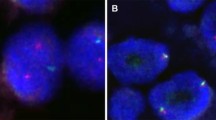Abstract
Molecular analysis has allowed for refinement of salivary gland tumor classification and, in some cases, the recognition of entirely new tumor types. Microsecretory adenocarcinoma (MSA) is a salivary gland tumor described in 2019 characterized by microcystic growth, bland cytomorphology, luminal secretions, fibromyxoid stroma, and S100/p63 positivity with negative p40. Most important, MSA is defined by MEF2C-SS18 fusion. While this fusion has, to this point, been detected by next-generation sequencing, this is a technique that is currently inaccessible in most diagnostic laboratories. On the other hand, SS18 break-apart fluorescence in situ hybridization (FISH) is widely available and frequently used as an adjunct for diagnosing synovial sarcoma. It is not known if SS18 break-apart FISH is positive in tumors with MEF2C-SS18, or if it is entirely specific for MSA. Break apart FISH for SS18 was performed on 4 cases of MSA, as well as 8 tissue microarrays (TMAs) containing 423 various salivary gland carcinomas: 26 acinic cell carcinomas, 35 adenocarcinomas not otherwise specified, 96 adenoid cystic carcinomas, 3 basal cell adenocarcinomas, 20 epithelial–myoepithelial carcinomas, 15 hyalinizing clear cell carcinomas, 3 intraductal carcinomas, 12 myoepithelial carcinomas, 117 mucoepidermoid carcinomas, 30 polymorphous adenocarcinomas, 45 salivary duct carcinomas, 19 secretory carcinomas, and 2 undifferentiated carcinomas. SS18 break-apart FISH was also performed on whole slides of 2 tumors from the TMAs. All MSA cases demonstrated classic split patterns on SS18 break-apart FISH. On the TMAs, 374 cases were evaluable by FISH, and 372 cases were clearly negative for SS18 rearrangement. Two cases, both mucoepidermoid carcinomas, had rare split signals below the positivity threshold of 12% on their TMA cores, so FISH was performed on whole sections. On the whole sections both tumors were unequivocally negative for SS18 rearrangement. Taken together, SS18 break-apart FISH was 100% sensitive and 100% specific for a diagnosis of MSA. SS18 break-apart FISH, a diagnostic tool widely available in pathology laboratories, appears to be a highly accurate method for diagnosing MSA of salivary glands. Accordingly, this new tumor type may be molecularly confirmed without needing to resort to highly specialized techniques like next-generation sequencing.

Similar content being viewed by others
References
Skalova A, Stenman G, Simpson RHW, Hellquist H, Slouka D, Svoboda T, et al. The role of molecular testing in the differential diagnosis of salivary gland carcinomas. Am J Surg Pathol. 2018;42(2):e11-27.
Bishop JA, Westra WH. MYB translocation status in salivary gland epithelial–myoepithelial carcinoma: evaluation of classic, variant, and hybrid forms. Am J Surg Pathol. 2018;42(3):319–25.
Bishop JA, Cowan ML, Shum CH, Westra WH. MAML2 rearrangements in variant forms of mucoepidermoid carcinoma: ancillary diagnostic testing for the ciliated and warthin-like variants. Am J Surg Pathol. 2018;42(1):130–6.
Ishibashi K, Ito Y, Masaki A, Fujii K, Beppu S, Sakakibara T, et al. Warthin-like mucoepidermoid carcinoma: a combined study of fluorescence in situ hybridization and whole-slide imaging. Am J Surg Pathol. 2015;39(11):1479–87.
Skalova A, Vanecek T, Sima R, Laco J, Weinreb I, Perez-Ordonez B, et al. Mammary analogue secretory carcinoma of salivary glands, containing the ETV6-NTRK3 fusion gene: a hitherto undescribed salivary gland tumor entity. Am J Surg Pathol. 2010;34(5):599–608.
Bishop JA, Weinreb I, Swanson D, Westra WH, Qureshi HS, Sciubba J, et al. Microsecretory adenocarcinoma: a novel salivary gland tumor characterized by a recurrent MEF2C-SS18 fusion. Am J Surg Pathol. 2019;43(8):1023–32.
Kawakami F, Nagao T, Honda Y, Sakata J, Yoshida R, Nakayama H, et al. Microsecretory adenocarcinoma of the hard palate: a case report of a recently described entity. Pathol Int. 2020;70(10):781–5.
Cheng L, Zhang S, Wang L, MacLennan GT, Davidson DD. Fluorescence in situ hybridization in surgical pathology: principles and applications. J Pathol Clin Res. 2017;3(2):73–99.
Weinreb I, Bishop JA, Chiosea SI, Seethala RR, Perez-Ordonez B, Zhang L, et al. Recurrent RET gene rearrangements in intraductal carcinomas of salivary gland. Am J Surg Pathol. 2018;42(4):442–52.
Togashi Y, Dobashi A, Sakata S, Sato Y, Baba S, Seto A, et al. MYB and MYBL1 in adenoid cystic carcinoma: diversity in the mode of genomic rearrangement and transcripts. Mod Pathol. 2018;31:934.
Funding
This study was funded in part by the Jane B. and Edwin P. Jenevein, MD Endowment for Pathology at UT Southwestern Medical Center.
Author information
Authors and Affiliations
Corresponding author
Ethics declarations
Conflict of interest
The authors declare that they have no conflict of interest.
Ethical Approval
This study was approved by the UT Southwestern institutional review board (STU 112017-073).
Additional information
Publisher’s Note
Springer Nature remains neutral with regard to jurisdictional claims in published maps and institutional affiliations.
Rights and permissions
About this article
Cite this article
Bishop, J.A., Koduru, P., Veremis, B.M. et al. SS18 Break-Apart Fluorescence In Situ Hybridization is a Practical and Effective Method for Diagnosing Microsecretory Adenocarcinoma of Salivary Glands. Head and Neck Pathol 15, 723–726 (2021). https://doi.org/10.1007/s12105-020-01280-7
Received:
Revised:
Accepted:
Published:
Issue Date:
DOI: https://doi.org/10.1007/s12105-020-01280-7




